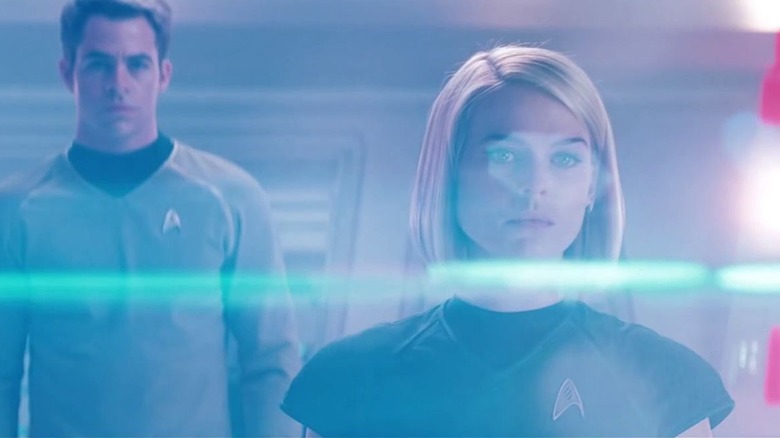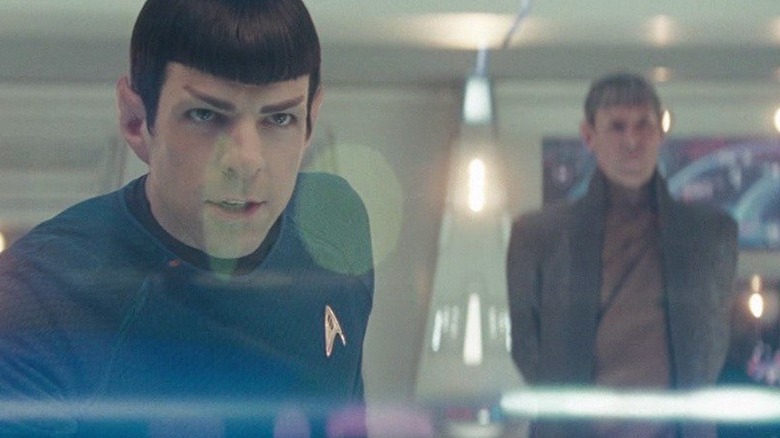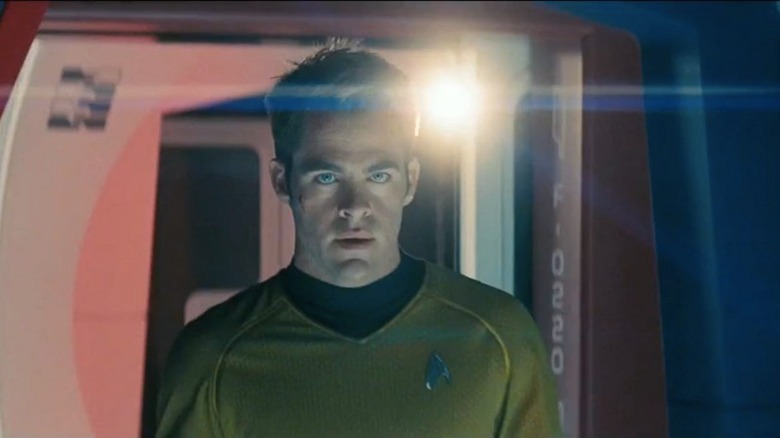How JJ Abrams Feels About His Infamous Use Of Lens Flare
As Timbuk 3 once astutely observed, the future's so bright, we gotta wear shades.
TV-impresario-turned-hit-filmmaker J.J. Abrams once had a bad filmmaking habit, and one that audiences were well aware of. Abrams, against the advice of his cinematographers, was very fond of deliberately including lens flare in his feature films, specifically "Star Trek" (2009) and "Star Trek Into Darkness" (2013). For several years, lens flare became the most notable element of Abrams' style as a filmmaker, along with his fluid camera movements and tantalizingly unresolved plot elements intended to be addressed in any potential sequels or follow-ups. While the fluid camera was handled reasonably well, and Abrams' unresolved plots did inspire no end of speculation — another of the filmmaker's trademarks was a closely guarded set, restricting the flow of information to the press and to pundits, thereby fueling the rumor mill into a combusting frenzy — it was the lens flare that became a problem. Abrams' overwrought lighting style was so pervasive, nearly every shot in his films featured large white blobs of light into the middle of the frame, often obscuring the action.
In an interview at the Tribeca Film Festival in 2016, J.J. Abrams talked to Chris Rock about his career, and Rock confronted Abrams about how he developed the bad lighting habit, and how he eventually had to actively break the habit.
What Causes Lens Flare?
Lens flare describes extra visual artifacts imprinted on a film from a rogue light source. If, for instance, a camera is pointed in the general direction of — but not directly at — the sun, extra light can strike the camera lens at just the wrong angle, reflecting the sunlight through the lens' curvature, and traveling into the camera as visual "flare." This sort of flaring can be seen in many low-budget films in the 1970s, as cameras on low-budget productions tended to be old or beaten up, and their lenses tended to be scratched or nicked. Those scratches and nicks could cause the now-infamous light leaks, leading to sunburst-shaped streaks, hexagonal patterns, and other inconvenient obfuscations on top of the image. Lens flare is typically reduced by the addition of lens hoods, but even that can be a problem, especially when shooting daytime exteriors. The most common type of lens flare is a simple reduction of image contrast, leading to a more milky visual.
Some audiences and filmmakers, however, became fond of the error, and filmmakers began deliberately including lens flare in their films as early as 1964. The first feature film to have notably included lens flare deliberately was Hiroshi Teshigahara's masterpiece "A Woman in the Dunes," shot by Hiroshi Sagawa. The use of lens flare in that film might have been used to highlight the sandy location — it's a film about a man who becomes stranded in a cabin at the bottom of a deep sand pit with a woman who may or may not be keeping him there deliberately. It's an excellent flick.
Action filmmakers like Michael Bay would later use CGI technology to add lens flare in an otherwise clean image to manufacture a sense you-are-there authenticity. Lens flare was also used extensively in the cult TV series "Firefly" (2002), as the show's photographer, David Boyd, wanted it to look like under-polished sci-fi shows of the 1970s. Boyd deliberately used older, scratched lenses to achieve his desired look. And, of course, J.J. Abrams — working with cinematographer Dan Mindel — used off-camera, high-powered flashlights to make the future look bright, bright, bright in 2009's "Star Trek."
The Future Is So Bright
After Abrams directed "Super 8" in 2011 and "Star Trek Into Darkness" in 2013, the director's overuse of lens flare had become a common joke among cineastes and fanboys. It was noticed.
When asked about it at Tribeca, Abrams declared openly and reassuringly "I'm over that." He went on to explain why he was drawn to that flaring aesthetic in the first place. It turns out he took Gene Roddenberry's vision that the future of humanity was going to be brighter, and took it literally:
"For a period of time, on 'Star Trek' (and I couldn't give it up on this other movie I did [referring to "Super 8"]), there was this idea we had ... that the future was so bright that it just couldn't be contained. That, and you had stuff happening, so if felt like — just off camera — there was something great! And there was this energy in this room! And it gave it this sort-of signature. And I overdid it. And then I went further. And then on the second 'Star Trek' movie, I went nuts. We've all made mistakes, right? Mine was with light. And we ended up ... we literally had flashlights. [Lens flares] weren't put in in post. We had flashlights off camera, these insane high powered flashlights. And we'd do the thing. Every director of photography is like, 'don't do that.' We aimed it right in the lens. And the lens would have a layer of coating on it to not flair, and we wouldn't use it. We got lenses that had no coating."
Abrams admit that felt bad about what he had ordered, and that he had convinced DPs, who otherwise knew better, to get into creating lens flares with high-powered flashlights. While reviewing dailies for the film, Abrams even saw that there were shots where he couldn't see that action on the screen. But he had a vision and stuck to it. His decision to end his habit came from a particularly badly-lit shot in "Star Trek Into Darkness," and, natch, some hard advice from his wife, Katie McGrath:
"It was a very emotional scene for [actress Alice Eve]. But it looked like bad reception. Like TV from the day TV was invented. My wife looked at it ... and she gave me that look. That was sort of like: 'You've come to the end. Stop.' So I realized it was preposterous, and I had to pull back."
Abram's next film after "Star Trek Into Darkness" was 2015's "Star Wars: The Force Awakens." Abrams is proud of the fact that the film features no lens flare whatsoever. Well, no deliberate flares; sometimes, in his words, "physics requires there to be a flare." But, as of this writing, Abrams will no longer use them. Now the future can be bright, but still visible.


